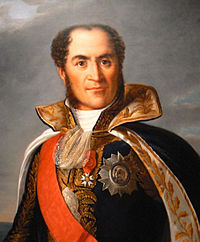- Guillaume-Marie-Anne Brune
-
Guillaume Marie Anne Brune, 1st Comte Brune 
Guillaume Marie-Anne BruneBorn 13 March 1763
Brive-la-Gaillarde, FranceDied 2 August 1815 (aged 52)
Avignon, FranceAllegiance  France
FranceRank Marshal of France Guillaume Marie Anne Brune, 1st Comte Brune (13 March 1763 – 2 August 1815) was a French soldier and political figure who rose to Marshal of France.
The son of a lawyer, he was born at Brive-la-Gaillarde, Corrèze. Brune settled in Paris before the French Revolution, studied law, and became a political journalist. Following the French Revolution he joined the Cordeliers and was a friend of Georges Danton. He was appointed Brigadier General in 1793 and took part in the fighting of the 13 Vendémiaire (5 October 1795) against royalist insurgents in Paris.
In 1796 he fought under Napoleon Bonaparte in the Italian campaign, and was promoted Général de Division for good service in the field. He commanded the French army which occupied Switzerland in 1798 and established the Helvetic Republic, and in the following year he was in command of the French troops in defence of Amsterdam against the Anglo-Russian Invasion of Holland under the Duke of York, which was completely successful - the invaders were defeated in the Battle of Castricum, and compelled, after a harsh retreat, to re-embark. He rendered further good service in Vendée and in the Italian Peninsula during the years 1799 - 1801 (winning the Battle of Pozzolo).
In 1802 Napoleon dispatched Brune to Constantinople as ambassador to the Ottoman Empire. During his two-year diplomatic service, he initiated relations between France and Persia.
Following his coronation as Emperor of the French in 1804, Napoleon made Brune Marshal of the Empire (Maréchal d'Empire). In 1807 Brune held a command of troops fighting in the North German campaign and occupied Swedish Pomerania, but Brune's staunch republicanism and a meeting between Brune and Gustav IV Adolf of Sweden raised Napoleon's suspicions, and he was not afterwards employed during the Empire.
Brune was recalled to active service in 1815, during the Hundred Days, and as commander of the army of the Var, he defended the south of France against the forces of the Austrian Empire. He was murdered by royalists during the White Terror at Avignon, during the opening stage of the Bourbon Restoration. His body was thrown in the river Rhône, but was later recovered and buried in a pyramid-shaped tomb in the cemetery of Saint-Just-Sauvage.
Personal life
In 1788 he married Jeanne Nicolas (? – 1840) and had 5 children:
- Angelique-Catherine (1791 – 1879)
- Camille (? – 1842)
- Jeanne-Madeleine (1797 – 1839)
- Sophie-Catherine (? – 1820)
- Nina (1800 – 1833)
References
 This article incorporates text from a publication now in the public domain: Chisholm, Hugh, ed (1911). Encyclopædia Britannica (11th ed.). Cambridge University Press. The 1911 Encyclopædia Britannica, in turn, gives the following references:
This article incorporates text from a publication now in the public domain: Chisholm, Hugh, ed (1911). Encyclopædia Britannica (11th ed.). Cambridge University Press. The 1911 Encyclopædia Britannica, in turn, gives the following references:
- Notice historique sur la vie politique et militaire du marechal Brune (Paris, 1821).
- Paul-Prosper Vermeil de Conchard, L'Assassinat du marechal Brune (Paris, 1887).
Marshals of the First French Empire  Categories:
Categories:- 1763 births
- 1815 deaths
- People from Brive-la-Gaillarde
- Marshals of France
- Military leaders of the French Revolutionary Wars
- French military personnel of the French Revolutionary Wars
- French commanders of the Napoleonic Wars
- French diplomats
- 1815 crimes
- French murder victims
- People murdered in France
- Grand Croix of the Légion d'honneur
- Ambassadors of France to the Ottoman Empire
Wikimedia Foundation. 2010.



